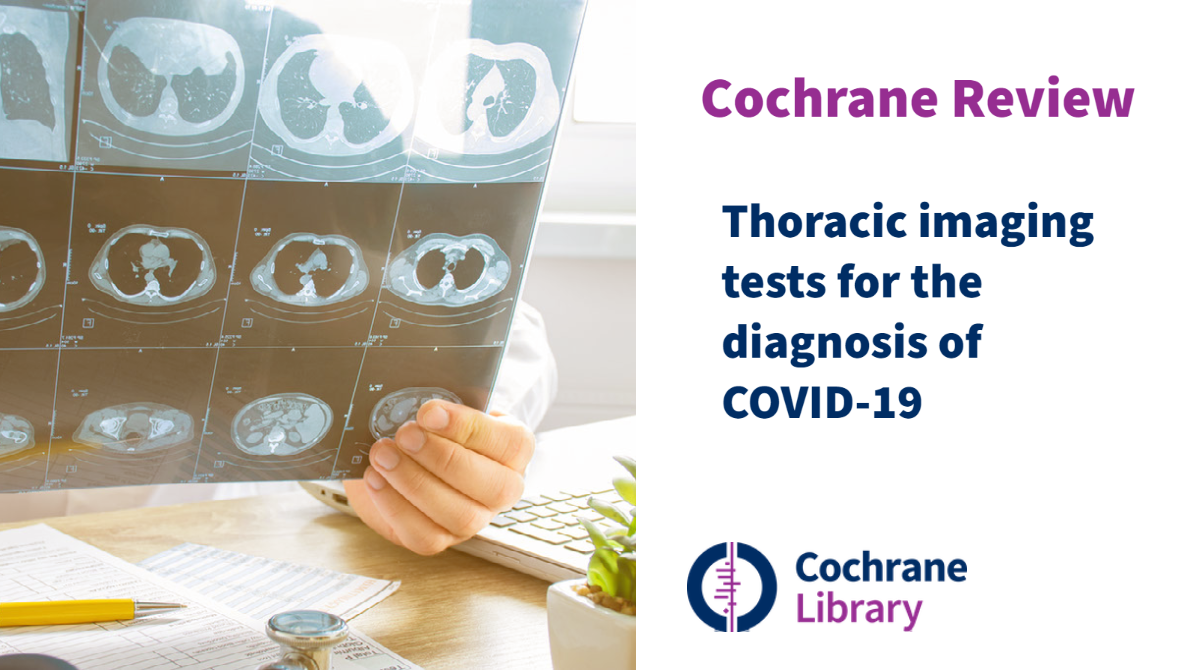
Updated Review: How accurate is chest imaging for diagnosing COVID-19?
Why is this question important?
People with suspected COVID-19 need to know quickly whether they are infected, so they can receive appropriate treatment, self-isolate, and inform close contacts.
Currently, formal diagnosis of COVID-19 requires a laboratory test (RT-PCR) of nose and throat samples. RT-PCR requires specialist equipment and takes at least 24 hours to produce a result. It is not completely accurate, and may require a second RT-PCR or a different test to confirm diagnosis.
COVID-19 is a respiratory disease. Clinicians may use chest imaging to diagnose people who have COVID-19 symptoms, while awaiting RT-PCR results or when RT-PCR results are negative, and the person has COVID-19 symptoms.
What did the authors want to find out?
The authors wanted to know whether chest imaging is accurate enough to diagnose COVID-19 in people with suspected infection. This is the second update of this review; in it the authors included studies in people with suspected COVID-19 only; they excluded studies in people with confirmed COVID-19.
The evidence is up to date to 30 September 2020.
What are chest imaging tests?
X-rays or scans produce an image of the organs and structures in the chest.
- X-rays (radiography) use radiation to produce a 2-D image. Usually done in hospitals, using fixed equipment by a radiographer, they can also be done on portable machines.
- Computed tomography (CT) scans use a computer to merge 2-D X-ray images and convert them to a 3-D image. They require highly specialised equipment and are done in hospital by a specialist radiographer.
- Ultrasound scans use high-frequency sound waves to produce an image. They can be done in hospital or other healthcare settings, such as a doctor’s office.
What did the authors do?
They searched for studies that assessed the accuracy of chest imaging to diagnose COVID-19 in people of any age with suspected COVID-19. Studies could be of any design, except for case control studies, and could take place anywhere.
What did they find?
The authors found 51 studies with 19,775 participants. Of these people, 10,155 (51%) had a final diagnosis of COVID‐19. Forty-seven studies confirmed COVID-19 infection using RT-PCR alone. Four studies used RT-PCR with another test.
Forty-seven studies evaluated one imaging technique each, and four studies evaluated two imaging techniques each.
Chest CT was evaluated by 41 studies (16,133 participants, 8110 (50%) confirmed COVID-19 cases), chest X‐ray by nine studies (3694 participants, 2111 (57%) confirmed COVID-19 cases), and ultrasound by five studies (446 participants, 211 (47%) confirmed COVID-19 cases). Thirty-three studies were conducted in Europe, 13 in Asia, three in North America and two in South America. Twenty-six studies included only adults, 21 included both adults and children, one included only children, one included participants aged 70 years and older, and two studies did not report participants' ages. Two studies included hospital inpatients and 32 included hospital outpatients. The setting was unclear in the remaining 17 studies.
Where four or more studies evaluated a particular type of chest imaging, the author team pooled their results and analysed them together.
Chest CT
Pooled results showed that chest CT correctly diagnosed COVID-19 in 87.9% of people who had COVID-19. However, it incorrectly identified COVID-19 in 20% of people who did not have COVID-19.
Chest X-ray
Pooled results showed that chest X-ray correctly diagnosed COVID-19 in 80.6% of people who had COVID-19. However, it incorrectly identified COVID-19 in 28.5% of people who did not have COVID-19.
Lung ultrasound
Pooled results showed that lung ultrasound correctly diagnosed COVID-19 in 86.4% of people with COVID-19. However, it incorrectly diagnosed COVID-19 in 45% of people who did not have COVID-19.

How reliable are the results?
The studies differed from each other and used different methods to report their results. Few studies evaluated chest X-ray and chest ultrasound; and very few studies directly compared one type of imaging test with another. Therefore, we cannot draw confident conclusions based on results from studies in this review.
What does this mean?
The evidence suggests that chest CT is better at ruling out COVID‐19 infection than distinguishing it from other respiratory problems. So, its usefulness may be limited to excluding COVID‐19 infection rather than distinguishing it from other causes of lung infection.
The author team plan to update this review as more evidence becomes available. Future studies should predefine what a positive test is, and compare different types of imaging tests on similar groups of people.

